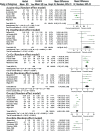The effectiveness of the Herbst appliance for patients with Class II malocclusion: a meta-analysis
- PMID: 26306822
- PMCID: PMC4914909
- DOI: 10.1093/ejo/cjv057
The effectiveness of the Herbst appliance for patients with Class II malocclusion: a meta-analysis
Abstract
Objective: To systematically investigate review in literature the effects of the Herbst appliance for patients with Class II malocclusion patients.
Method: We performed a comprehensive literature survey on PubMed, Web of Science, Embase, CENTRAL, SIGLE, and ClinicalTrial.gov up to December 2014. The selection criteria: randomized controlled trials or clinical controlled trials; using any kind of Herbst appliances to correct Class II division 1 malocclusions; skeletal and/or dental changes evaluated through lateral cephalograms. And the exclusion criteria: syndromic patients; individual case reports and series of cases; surgical interventions. Article screening, data extraction, assessment of risk of bias, and evaluation of evidence quality through GRADE were conducted independently by two well-trained orthodontic doctors. Consensus was made via group discussion of all authors when there is inconsistent information from the two. After that, sensitivity analysis and subgroup analysis were performed to evaluate the robustness of the meta-analysis.
Results: Twelve clinical controlled trials meet the above-mentioned criteria, and were included in this analysis. All included studies have eleven measures taken during both active treatment effect and long term effect periods, including four angular ones (i.e., SNA, SNB, ANB, mandibular plane angle) and seven linear ones (i.e. Co-Go, Co-Gn, overjet, overbite, molar relationship, A point-OLp, Pg-OLp) during active treatment effect period were statistically pooled. Meta-analysis and sensitivity analysis demonstrated that all these measures showed consistent results except for SNA, ANB, and overbite. Subgroup analysis showed significant changes in SNA, overbite, and Pg-OLp. Publication bias was detected in SNB, mandibular plane angle, and A point-OLp.
Conclusion: The Herbst appliance is effective for patients with Class II malocclusion in active treatment period. Especially, there are obvious changes on dental discrepancy and skeletal changes on Co-Gn. As to its long-term effects, more evidence is needed to draw conclusions.
© The Author 2015. Published by Oxford University Press on behalf of the European Orthodontic Society. All rights reserved. For permissions, please email: journals.permissions@oup.com.
Figures



References
-
- Tung A.W. and Kiyak H.A (1998) Psychological influences on the timing of orthodontic treatment. American Journal of Orthodontics and Dentofacial Orthopedics, 113, 29–39. - PubMed
-
- Dann C. IV Phillips C. Broder H.L. and Tulloch J.F (1995) Self-concept, Class II malocclusion, and early treatment. The Angle Orthodontist, 65, 411–416. - PubMed
-
- Pancherz H. (1979) Treatment of class II malocclusions by jumping the bite with the Herbst appliance. A cephalometric investigation. American Journal of Orthodontics, 76, 423–442. - PubMed
-
- Howe R.P. (1982) The bonded Herbst appliance. Journal of Clinical Orthodontics, 16, 663–667. - PubMed
-
- Franchi L. Baccetti T. and McNamara J.A. Jr (1999) Treatment and posttreatment effects of acrylic splint Herbst appliance therapy. American Journal of Orthodontics and Dentofacial Orthopedics, 115, 429–438. - PubMed
Publication types
MeSH terms
LinkOut - more resources
Full Text Sources
Other Literature Sources
Research Materials

